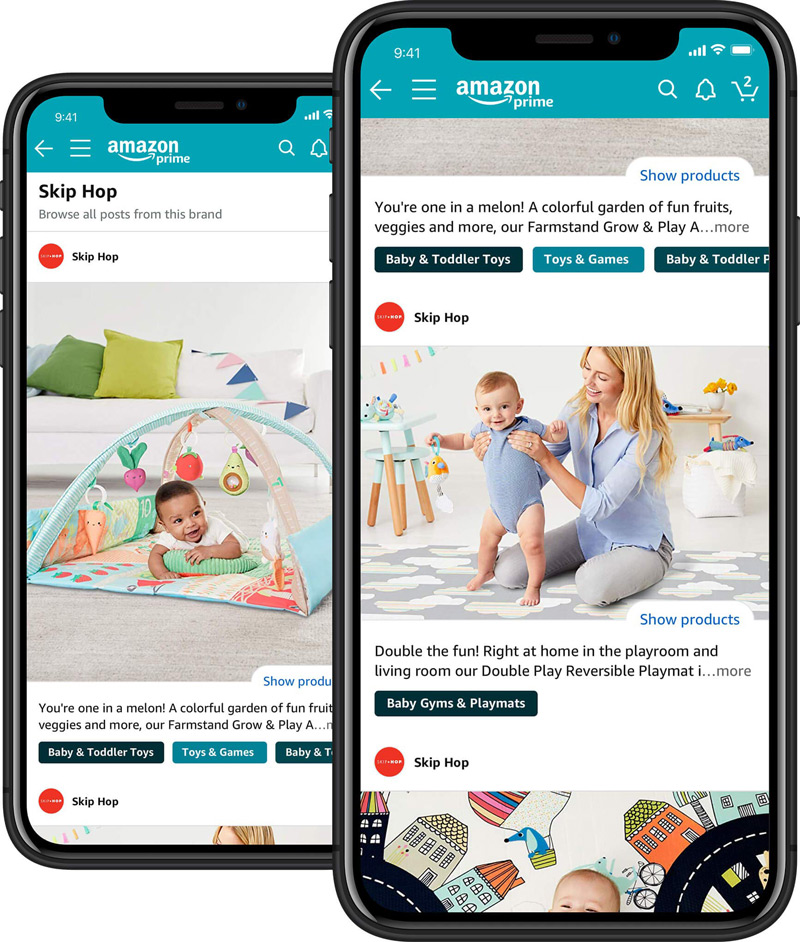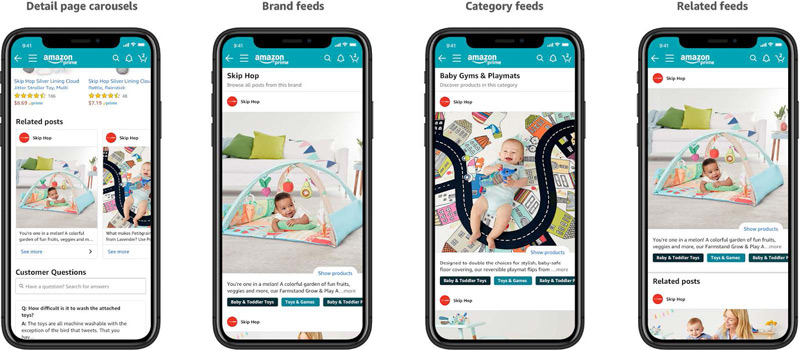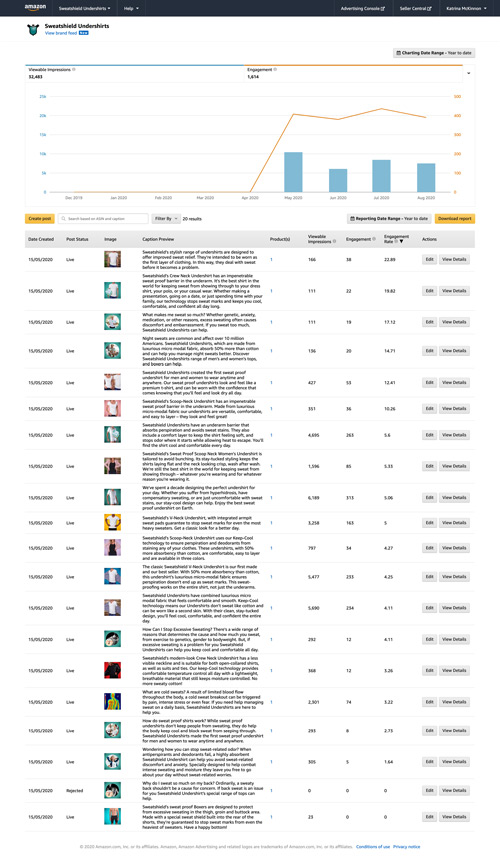The competition in eCommerce is cutthroat.
Every online brand and retailer wants the biggest share of the market they can get. And the competition is particularly stiff on online marketplaces such as Amazon.
Amazon is the world’s biggest eCommerce platform — as of 2019, it had over 2.5 million active sellers.
Moreover, Amazon boasts of 95 million Prime members in the US and over 150 million Prime members worldwide.
If you sell on Amazon, it’s easy for your brand to go unnoticed. Therefore, eCommerce store owners often use different tools to make their products more discoverable.
Amazon Posts is one of the most powerful tools to improve your products’ visibility in the popular marketplace.
Although still in the beta phase, this tool is set to revolutionize eCommerce advertising.
Tip: Wanna supercharge your Amazon store? Join the eCommerceFuel community to learn from a vibrant group of people like you — other online store owners!
What Are Amazon Posts?

Amazon Posts functions similar to social media feeds — it offers shoppers an image-based browsing experience on Amazon.
The idea is to allow shoppers to explore brand-specific feeds, or browse by product categories to discover new brands.
Amazon Posts link to product detail pages, making it easier for shoppers to make a purchase.
The feature is currently available to US vendors and sellers enrolled in the Amazon Brand Registry.
Read on to learn more about what Posts can do for your business, and how to leverage the tool.
Where Do Amazon Posts Appear?
Posts allow eCommerce vendors to display multiple items in a carousel on product pages.
The posts will also show up in several areas of the platform to grab shoppers’ attention.
Currently, branded posts can be published in the following places:
- Brand-owned details page — Where your product is included in the “Customers who bought this item also bought” and the “Customer’s Questions” sections. These allow you to cross-sell your brand’s other products to interested buyers.
- Related brands details page — Where your products are listed next to those of your competitors. They’re listed as “related posts” or “related products.” This is a great way to introduce your brand to buyers who are checking out your competitors’ items.
- Related post feed — When shoppers click on a post, they will be able to view other related posts. Yours might appear in this section.
- Category feed — Category-based feeds are determined by the category tags that Amazon assigns to posts. If a shopper clicks on a tag, they will see all the products that have that tag.

Unfortunately, you won’t be able to choose where your post will be published — Amazon controls this.
But, the category tags you use do have some influence on your post’s final destination.
Each Amazon Post links to the product details, making them instantly shoppable. This means that users can click and go to the product details page, where they can then add it to their eShopping cart.
Unlike social media pages, the feature doesn’t allow interactions. It doesn’t allow commenting, liking, voting, or expressing an opinion using emojis.
Benefits of Using Amazon Posts
If you have access, posts are a great way to advertise your products on Amazon.
Let’s explore some of the reasons you should start using this innovative feature:
Build Brand Awareness to Boost Conversion Rates
There are people out there that need and want your products.
If you can put your brand in front of them, you increase the clickthrough rates. The more places you appear, the higher the likelihood of conversion.
Posts increase your brand and product visibility on Amazon, and this, in turn, strengthens your brand name awareness.
Posts are also a great way to extend your online marketing reach for free.
Edge Out the Competition
When your posts appear on your competitor detail pages, this allows you to draw them to yours.
Shoppers checking out your competitors’ products are probably highly interested in buying.
If they see and read your detail pages, they might opt for your product instead.
Experiment With Creative Posts
Are you always testing new ideas to increase clicks and clickthrough rates on Amazon?
Unlike a normal detail page, posts don’t have strict requirements about images and copy. The feature provides a low-risk avenue to test creative visual advertising ideas.
Plus, Amazon Posts have metrics to allow you to view impressions, clicks, and clickthrough rates for featured products.
This means you can try different ideas to find what resonates best with your target audience.
How to Make the Most of Your Amazon Posts
Because the Amazon feature is still in development, there’s little information about it.
To get a head start in the game, here are a few helpful tips:
- Pay attention to quality: Post high-quality visual content to attract attention to your brand. Your message should be consistent with your brand identity.
- Post often: In the world of eCommerce, content is king. The more often you post, the more likely you are to grab the attention of shoppers. Luckily, Amazon doesn’t limit how much you can post — fill the “Related Products” and “Product Categories” with as much content as you can before it becomes crowded.
- Keep an eye on the metrics: To find out the kind of posts that shoppers like, take full advantage of the metrics offered by Amazon Posts. With these, you can tell what shoppers are most interested in, the tactics that work, and which detail pages need more attention.

Luckily for us, Tinuiti experimented with creating Posts. Here are their findings:
- Keep your captions short (4–5 words) for optimum engagement.
- Use A/B testing to find out what type of images and captions work best.
- Edit your posts. The editing feature allows you to alter images, captions, and even the ASIN.
- If your product runs out of stock, the Post won’t have much positive impact.
Current Challenges and Limitations
Like any other free ad placement, there will be a couple of trade-offs. Amazon Posts has its fair share of challenges and limitations.
Limited Control of Posts
You won’t be ab
le to determine where your ad will be placed.
Limited Data Access for Sellers
Amazon provides limited data on how posts perform.
With only being able to view impressions, clicks, and clickthrough rates, you won’t have insight into revenue or orders. This makes it difficult to calculate ROI.
Changing Shopper Behaviour Might Be Difficult
Most shoppers aren’t yet aware of Amazon Posts.
There’s no guarantee that they’ll click on the carousel that leads to more posts.
Changing shoppers’ behavior to engage with posts and open product detail pages might take some time.
Might It Be the Next Google+?
Google would prefer that you don’t remember the failed experiment that was Google+ — their attempt at creating a social media site for fear of losing out to Facebook. The Google+ social media experiment was shut down in April 2019.
Amazon Posts is a lot like Google+, in that it doesn’t offer anything truly unique.
It bears an uncanny resemblance to Instagram, and with the saturation of social media platforms, many people might not be willing to explore an additional one for shopping.

Newest Features on Amazon Posts
Because it’s still being developed, Amazon Posts has had a few tweaks happen to it in the recent past. Here are a few:
- Multi-product posts: Vendors can showcase various products in one post. This feature allows you to display a collection, variations of a product, or complementary products.
- Schedule posts: Just like with media platforms, you can schedule your posts in advance. This makes it easier to integrate Amazon Posts into your social media marketing strategy.
- Downloadable reports: You can select a date range and download a report on your posts’ impressions and engagement.
How to Join Amazon Posts
Still in its beta phase, Amazon Posts is currently restricted to brands that have an Amazon store on the US Amazon site.
If you qualify, you can sign up for Amazon Posts and start boosting your brand. Here are the steps to follow:
- Open posts.amazon.com
- Sign in using your Amazon advertising credentials
- Create a profile
- Verify your brand name
- Upload your brand logo
- Start creating posts with photos
How to Create Amazon Posts
You can publish your posts on a desktop or by using the mobile app, and you can do so via your Seller or Vendor Central Account.

To create an Amazon post, follow these steps:
- Upload a product image
- Write a short caption
- Choose the product ASIN
- Review the post in the window to the right
- Submit the post for review
Before you get started, here are the specifications for posts:
- Your profile logo must be your brand logo. It should be no smaller than 640×640 pixels
- A post’s image aspect ratio should be 1×1, 16×9, and 4×3
- The caption text can include up to 2,200 characters
Bottom Line: Take Advantage of Amazon Posts Now
Amazon Posts provides a great opportunity for vendors to promote their products in the competitive marketplace.
You don’t have to dive into Amazon Posts right away. If you’d prefer, you can opt to wait for the final version.
But, if you do decide to try it out, it’s smart to start experimenting soon, as Amazon Posts is currently free. As more vendors start using the feature, there’s a high probability that Amazon will start charging for it.
Adding Amazon Posts to your advertising strategy should be quite easy; you can repurpose content from other social media sites for the platform.
But, bear in mind that these posts are about selling — not sharing or driving conversation.
To do it right from the start, consider hiring an Amazon expert.
Finally, join eCommerceFuel Community to tap into a highly experienced pool of store owners. These like-minded entreprepreneurs are willing to share what’s working in their business to help you grow your business faster.
Photo by Freepik